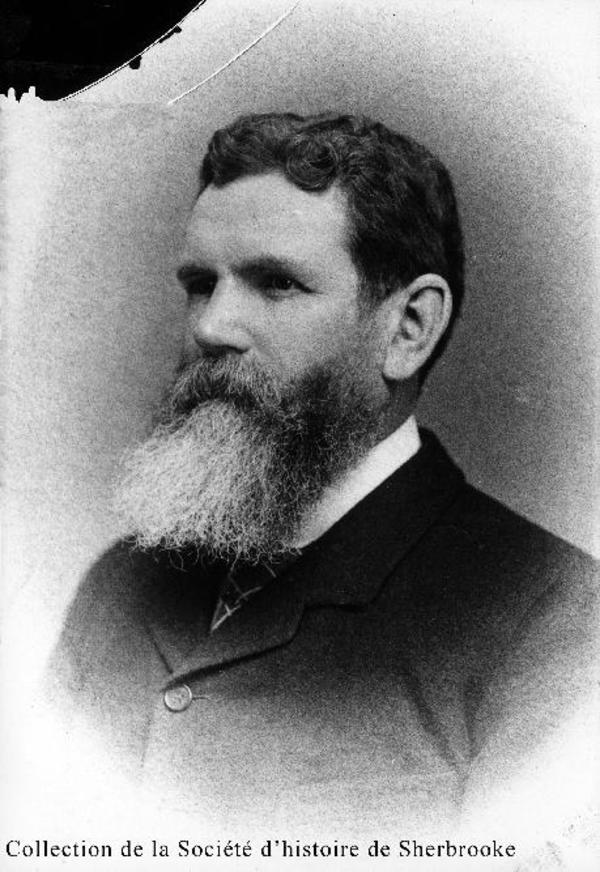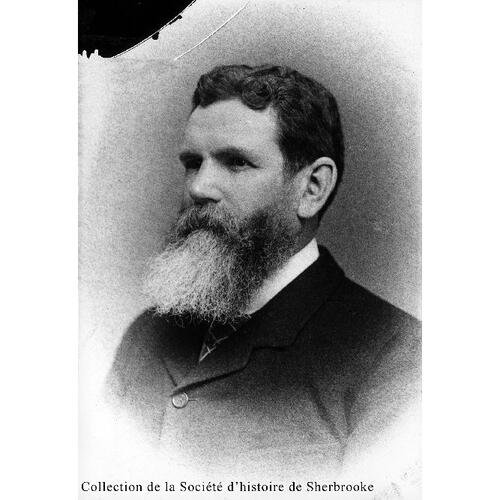
Source: Courtesy of Wikimedia Commons
PATON, ANDREW, manufacturer and politician; b. 5 April 1833 in Torbrex (Stirling), Scotland, son of James Paton and Mary Harvey; m. 17 Feb. 1859 Isabella Moir in Galt (Cambridge), Upper Canada, and they had six children; d. 23 Oct. 1892 in Sherbrooke, Que.
Early career
Andrew Paton began his career in manufacturing woollens as a young apprentice in the firm of J. and D. Paton at Tillicoultry, near Torbrex, and after his apprenticeship was completed he continued to work in this factory until his departure for Canada in 1855. He set up his own small firm in Galt, before moving on in 1861 to nearby Waterloo, where he was one of the partners in the Paton and Brickes woollen mill.
Paton’s real distinction came after his move five years later to Sherbrooke, in the Eastern Townships, Lower Canada. In 1866 Sherbrooke was a small town with a population of some 3,000 in which no single firm employed more than 50 workers. The region’s principal landowner, the British American Land Company [see Richard William Heneker*], saw in the establishment of a large firm a means to encourage higher property values and it offered free land and water power to Paton. The presence of local investors prepared to aid in the establishment of a woollen mill was no doubt an equally strong incentive for Paton to move to Sherbrooke. A. Paton and Company was formed in June 1866; Paton and the firm’s five other partners were to contribute $50,000 in capital to start up operations. Three of the partners were Richard William Heneker, Benjamin Pomroy, and John Henry Pope*, prominent local capitalists who had joined forces to establish the Eastern Townships Bank, chartered in 1855 and opened in 1859. These men formed part of a small group of assertive English-speaking businessmen in the region, to which Paton soon belonged. The two remaining partners in the woollen manufacturing company were George Stephen* and Alexander Mitchell of Montreal.
A. Paton and Company achieves success
Within four years the mill was employing nearly 200 workers and was the major force pushing the population of Sherbrooke up to 4,500 by 1871. It also contributed to a dramatic shift in the ethnic and linguistic character of the city: the employment of a largely French-speaking workforce at the mill was responsible for an increase in the relative size of the local French population from 24 per cent in 1861 to 51 per cent in 1871.
Despite the apparent success of the mill, Paton’s personal position within the firm had deteriorated by the early 1870s. In the original agreement he was given full control of the firm and named “general partner,” with a capital investment of only $5,000. The other “special partners,” who invested $10,000 each (except for Heneker and Mitchell who invested only $5,000), remained at a distance from the day-to-day operations of the mill. In July 1868, finding himself over $2,000 in debt to the firm, Paton sought an adjustment in the terms of partnership. The assets of A. Paton and Company were transferred to the Paton Manufacturing Company of Sherbrooke, a joint-stock company with an authorized capital of $100,000 in which Paton was but a minor shareholder. He served as the mill’s manager and sat on the board of directors until his death in 1892, but gave up his control of the company in return for the elimination of his personal debt.
Under the new incorporation the firm continued to prosper, and Paton remained important to the success of the mill. The correspondent for R. G. Dun and Company reported in September 1868 that the firm was “likely to do well” and that Paton “had experience, is a good bus[iness] man & manages the bus[iness].” Three years later the same source reported that the insured value of the company stood at $150,000 and that “Paton the Manager is a practical man & the concern is succeeding.” The depression of the mid 1870s did not appear to hurt the mill; none of its operations were closed down and there was no reduction in the number of employees. In 1877 the company employed 483 workers, by 1882 this figure had increased to 540, and by 1892, when the Sherbrooke mill was recognized as the largest woollen mill in Canada, the workforce numbered 725.
The relations that Paton cultivated between management and labour in the mill would appear to have been comparatively cordial. His performance in 1888 before the royal commission on the relations of labour and capital [see James Sherrard Armstrong*] revealed a more humane approach to management than that of many other factory operators, who described the poor working conditions they permitted in their plants. Paton, however, spoke of a shop in which fines were rarely charged and pains were taken to explain all rules to the employees.
The development of the Eastern Townships
The mill that Paton established in Sherbrooke was a major factor in the city’s expansion during the last decades of the 19th century. His personal involvement in this growth, however, went beyond his business activity. As a member of the Sherbrooke city council for eight years he was a strong supporter of municipal bonuses for industrial firms interested in establishing operations there. He was also an influential member of the local board of trade, serving as president at the time of his death, and was especially active in its endeavours to attract industry to Sherbrooke. With this expansion, however, the English-speaking élite saw its position undermined by the emergence of a French-speaking majority in the city. Other English-speaking notables, such as Heneker, engaged in nasty conflicts with the local French population, but Paton seems to have kept his distance from such controversy.
Growth in the region was also accompanied by a decline in the power of local business leaders and a shift towards monopoly-capitalist interests in Montreal. Since the 1860s the small group of English-speaking businessmen based in Sherbrooke, which Paton joined upon his arrival in 1866, had directed the economic development of the Eastern Townships. By the 1890s more powerful concerns centred in Montreal were exercising a controlling influence. Illustrative of this shift was the choice of John Turnbull, a Montrealer, by a board of directors dominated by George Stephen, another Montrealer, to assume the management of the Paton Manufacturing Company’s woollen mill following Paton’s death in 1892. The marriage in 1890 of Paton’s eldest daughter to prominent Montreal capitalist Herbert Samuel Holt* may be seen as another sign of the increasingly close relations between the Montreal élite and that of the Eastern Townships.
Paton’s career marked a particular phase in the economic history of the Eastern Townships and his passing may be seen as a symbol of the loss of control over the local economy by men rooted in the region. Tributes from his workers in local obituaries suggest that the deterioration of relations in the mill at the beginning of the 20th century may have been more than coincidental with the change in management. Andrew Paton, at his death, had the distinction of being one of the few members of the English-speaking élite of Sherbrooke to be hailed for his contribution to the growth of the region in both the French and the English press at a time when the changing balance between the two groups was a source of considerable tension.
ANQ-E, CN1-27, 23 juin 1866. Baker Library, R. G. Dun & Co. credit ledger, Canada, 4: 535 (mfm. at NA). Cleyn and Tinker Company Arch. (Huntingdon, Que.), Paton Manufacturing Company papers. Can., Prov. of, Statutes, 1855, c.206. Can., Royal commission on labour and capital, Report. Que., Statutes, 1875, c.67. Gazette (Montreal), 24 Oct. 1892. Monetary Times, 28 Oct. 1892. Montreal Daily Star, 24 Oct. 1892. Le Pionnier, 28 oct. 1892. Le Progrès de l’Est (Sherbrooke, Qué.), 15, 28 oct. 1892. Cyclopædia of Canadian biog. (Rose and Charlesworth), 2: 448. L.-P. Demers, Sherbrooke: découvertes, légendes, documents . . . (Sherbrooke, 1969).
Bibliography for the revised version:
Bibliothèque et Arch. Nationales du Québec, Centre d’arch. de Sherbrooke, CE501-S69, 26 oct. 1892. FamilySearch, “Canada, Ontario county marriage registers, 1858–1869,” Andrew Paton and Isabella Moir, Waterloo County, 17 Feb. 1859.
Cite This Article
Ronald Rudin, “PATON, ANDREW,” in Dictionary of Canadian Biography, vol. 12, University of Toronto/Université Laval, 2003–, accessed December 20, 2025, https://www.biographi.ca/en/bio/paton_andrew_12E.html.
The citation above shows the format for footnotes and endnotes according to the Chicago manual of style (16th edition). Information to be used in other citation formats:
| Permalink: | https://www.biographi.ca/en/bio/paton_andrew_12E.html |
| Author of Article: | Ronald Rudin |
| Title of Article: | PATON, ANDREW |
| Publication Name: | Dictionary of Canadian Biography, vol. 12 |
| Publisher: | University of Toronto/Université Laval |
| Year of publication: | 1990 |
| Year of revision: | 2025 |
| Access Date: | December 20, 2025 |



